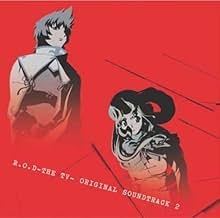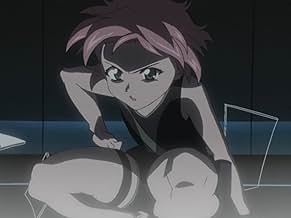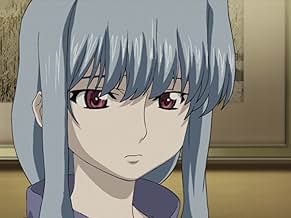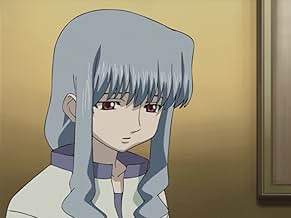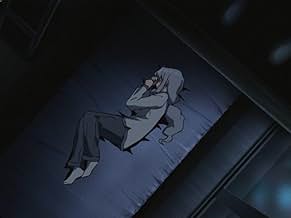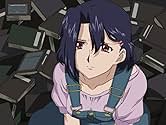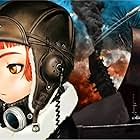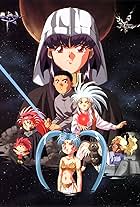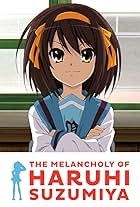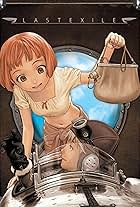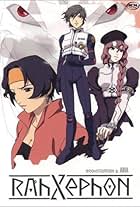Nenene, a famous female writer, hires the Paper Sisters, so named due to their ability to manipulate and control paper, as bodyguards.Nenene, a famous female writer, hires the Paper Sisters, so named due to their ability to manipulate and control paper, as bodyguards.Nenene, a famous female writer, hires the Paper Sisters, so named due to their ability to manipulate and control paper, as bodyguards.
Browse episodes
Storyline
Did you know
- TriviaThe names of the "Paper Sisters" are loosely inspired by three famous Hong Kong actresses: Maggie Cheung, Michelle Yeoh (who has also been credited as "Michelle Khan") and the late Anita Mui. Alternatively, a possible reference (pertaining to Anita's surname) is Hong Kong actress Michelle Reis, whose surname means "king" in Portuguese (her father being Portuguese).
- GoofsOne weakness of Paper Masters (revealed when the Three Sisters are in the Gifu prefecture hot springs) is that water can dampen their ability to control paper. Yomiko Readman and Sunny Wong have some way of overcoming this, but the Three Sisters do not (Joker later uses this weakness against the girls when he confronts them in the National Diet Library). However, as seen at the end of Twilight of the Papers, Anita forms and holds an underwater bubble to help her and Nenene escape from Dokusensha as the building sinks into the ocean (due to a bomb that Joker had planted).
- ConnectionsFeatured in Anime Unleashed: R.O.D. The TV Commercial (2003)
- SoundtracksR.O.D
Opening Theme (Episodes 2-25)
Performed by YKZ
Featured review
I found R.O.D the TV an outstanding anime: good story, interesting characters, captivating interaction, action and effects, deep emotions, music, grand back-story, cultural hints, good drawing -- it had it all. And all that with some rather unusual story elements.
The anime is a spin off of the successful Read or Die book series, which revolves around a Japanese-English girl with a Harry Potterish look named Yomiko Readman. The franchise spawned manga and anime adaptations. R.O.D the TV continues the Read or Die OVA, but takes it into darker, more serious and mature heights.
In the world of R.O.D, real power is held by two kryptocracies, which strive to rule -- the first unconventional element -- not by commanding armies, but controlling knowledge, especially in book form: the British Library and a Chinese secret society named Dokusensha. Befitting the theme, the series is full of cultural links and hints at a global level, from H.G. Wells through Anne of Green Gables to Hong Kong cinema (though the series' perfect Englishman seems to display Japanese business behavior).
The heroes of the series are agents doing the dirty work for the two superpowers, who come to realise that they are mere tools in much bigger games, and get between the fronts. Like in the real world, organisations are stronger than individuals (even if with special powers). Later in the series, an overwhelming feeling weighing down on the viewer is built with a series of battles lost (another uncommon story element).
The various agents display a number of fantastic special abilities, but the uncontested most spectacular remains the original idea: the 'paper masters' are bookworms who can control and shape paper, a telekinetic origami.
While there is a lot of action, knowledge is wielded as the most dangerous weapon, as the main adversary wins battles mostly with tricks and deception. Also, it's rare in fiction that the potency of half-truths is recognised: easier to sell and harder to unravel than full lies. In this anime however, things are told about people's past to discourage them, good memories are told to only be implanted ones, and the victims will not learn how much of that is true, and if cheesiest story elements are their real past self or pulp fiction.
It is also unusual that the two kryptocratic superpowers aren't 'evil', aren't villains from Bond movies like the antagonists in most anime (also the Read or Die OVA), but actually believe to work for the betterment of humanity. At one point, one of the main characters, by then trying to stop them, asks, 'could it be that we are the bad guys?'.
However, in line with an anime tradition at least since Evangelion, there are only hints and flashes of this big story in the first half of the series, when we learn to know the main protagonists, most of them female. Assignments alternate with idle time basically spent with hanging around at home.
Especially in the latter parts, what I find great in anime drawing is superb: light and shadow. The light of sunset, light between the shadows of skyscrapers, the light from a neighbouring room shining into a dark room, backlight, reflections on glass surfaces; mood-establishing light.
Yomiko Readman herself doesn't appear until half the series. At centre are three girls who adopted each other as sisters, and who protect a novelist. These characters are amazingly well worked out. Anita, the youngest 'sister' has all the playfulness and mood swings of a child, not the artificality of a Disney movie child or the spoilt brat of other animes. The secretary of the main adversary strives hard to give the best service to her boss, contrary to her earlier clumsy self, giving off small hints at internal tension and fear of failure. The stottering shyness of Maggie, the middle 'sister' is subdued, doesn't turn around in highschool movie style, and hints at untold stories. There are a lot of hints at untold stories. Despite an almost female-only main cast, there is very little fanservice.
Not only the main characters, but their relationships were well worked-out, too, with great attention for meta-communication.
The three 'sisters' complement each other and have a multitude of small bonding rituals. Most capturing is the relationship of the youngest sister and the young but grumpy novelist, an attachment shining through constant teases and complaints. Most of the relationships are again told via hints, the love story of oldest sister Michelle and a choleric killer entirely so: pauses and stolen looks, and a scene together at the end.
The overriding emotion is a melancholy to all main characters, especially said killer, captivating the viewer. I explain both this and the strong bonds with the fact that all of them are orphaned somehow, and in different ways, all really long for family.
All in all, I consider this is an underrated masterpiece, 10/10. I think it calls for a big-budget live-action adaptation, but only if they find real good actors.
The anime is a spin off of the successful Read or Die book series, which revolves around a Japanese-English girl with a Harry Potterish look named Yomiko Readman. The franchise spawned manga and anime adaptations. R.O.D the TV continues the Read or Die OVA, but takes it into darker, more serious and mature heights.
In the world of R.O.D, real power is held by two kryptocracies, which strive to rule -- the first unconventional element -- not by commanding armies, but controlling knowledge, especially in book form: the British Library and a Chinese secret society named Dokusensha. Befitting the theme, the series is full of cultural links and hints at a global level, from H.G. Wells through Anne of Green Gables to Hong Kong cinema (though the series' perfect Englishman seems to display Japanese business behavior).
The heroes of the series are agents doing the dirty work for the two superpowers, who come to realise that they are mere tools in much bigger games, and get between the fronts. Like in the real world, organisations are stronger than individuals (even if with special powers). Later in the series, an overwhelming feeling weighing down on the viewer is built with a series of battles lost (another uncommon story element).
The various agents display a number of fantastic special abilities, but the uncontested most spectacular remains the original idea: the 'paper masters' are bookworms who can control and shape paper, a telekinetic origami.
While there is a lot of action, knowledge is wielded as the most dangerous weapon, as the main adversary wins battles mostly with tricks and deception. Also, it's rare in fiction that the potency of half-truths is recognised: easier to sell and harder to unravel than full lies. In this anime however, things are told about people's past to discourage them, good memories are told to only be implanted ones, and the victims will not learn how much of that is true, and if cheesiest story elements are their real past self or pulp fiction.
It is also unusual that the two kryptocratic superpowers aren't 'evil', aren't villains from Bond movies like the antagonists in most anime (also the Read or Die OVA), but actually believe to work for the betterment of humanity. At one point, one of the main characters, by then trying to stop them, asks, 'could it be that we are the bad guys?'.
However, in line with an anime tradition at least since Evangelion, there are only hints and flashes of this big story in the first half of the series, when we learn to know the main protagonists, most of them female. Assignments alternate with idle time basically spent with hanging around at home.
Especially in the latter parts, what I find great in anime drawing is superb: light and shadow. The light of sunset, light between the shadows of skyscrapers, the light from a neighbouring room shining into a dark room, backlight, reflections on glass surfaces; mood-establishing light.
Yomiko Readman herself doesn't appear until half the series. At centre are three girls who adopted each other as sisters, and who protect a novelist. These characters are amazingly well worked out. Anita, the youngest 'sister' has all the playfulness and mood swings of a child, not the artificality of a Disney movie child or the spoilt brat of other animes. The secretary of the main adversary strives hard to give the best service to her boss, contrary to her earlier clumsy self, giving off small hints at internal tension and fear of failure. The stottering shyness of Maggie, the middle 'sister' is subdued, doesn't turn around in highschool movie style, and hints at untold stories. There are a lot of hints at untold stories. Despite an almost female-only main cast, there is very little fanservice.
Not only the main characters, but their relationships were well worked-out, too, with great attention for meta-communication.
The three 'sisters' complement each other and have a multitude of small bonding rituals. Most capturing is the relationship of the youngest sister and the young but grumpy novelist, an attachment shining through constant teases and complaints. Most of the relationships are again told via hints, the love story of oldest sister Michelle and a choleric killer entirely so: pauses and stolen looks, and a scene together at the end.
The overriding emotion is a melancholy to all main characters, especially said killer, captivating the viewer. I explain both this and the strong bonds with the fact that all of them are orphaned somehow, and in different ways, all really long for family.
All in all, I consider this is an underrated masterpiece, 10/10. I think it calls for a big-budget live-action adaptation, but only if they find real good actors.
Details
Contribute to this page
Suggest an edit or add missing content


